
* Corresponding author.
E-mail address: Elzbieta.DabrowskaMas@valeant.com (E. Dąbrowska-Maś)
© 2017 Growing Science Ltd. All rights reserved.
doi: 10.5267/j.ccl.2017.6.002
Current Chemistry Letters 6 (2017) 167–176
Contents lists available at GrowingScience
Current Chemistry Letters
homepage: www.GrowingScience.com
Metronidazole citrate ester as the new prodrug of metronidazole
Elżbieta Dąbrowska-Maś* and Wojciech Raś
Synthesis Laboratory, ICN Polfa Rzeszów S.A., Przemysłowa 2, 35-959 Rzeszow, Poland
C H R O N I C L E A B S T R A C T
Article history:
Received March 2, 2017
Received in revised form
June 1, 2017
Accepted June 21, 2017
Available online
June 22, 2017
Many attempts have been made since 1960th to obtain ester prodrugs of metronidazole active
moiety to be used for parenteral forms, with the same action against microorganisms. Until
now there is not any ester prodrug marketed for this route of administration. The synthesis
from metronidazole and citric acid of new ester prodrug of metronidazole with citric acid in a
form of disodium salt and the way of purification were described. The structure of sodium
metronidazole citrate was elucidated with IR, MS, 1H NMR and 13C NMR spectra. Also
impurities present in this ester were identified using 1H NMR technique. Additionally, the
solubility in water was measured as well as pH of 10% (w/w) aqueous solution, and both values
indicated that there is a possibility to obtain concentrated solutions for injection of neutral pH,
even without need of buffering. Finally, the Ames assay using six tester strains S. typhimurium
TA98, TA100, TA1535, TA1537 and E. coli uvrA, [pKM101] shown weak genotoxic
potential, comparable with metronidazole.
© 2017 Growing Science Ltd. All rights reserved.
Keywords:
Ames assay
Ester of metronidazole
Impurity profile
Metronidazole citrate disodium
Metronidazole prodrug
1. Introduction
Metronidazole is a synthetic agent 1-(2-Hydroxyethyl)-2-methyl-5-nitroimidazole (see Fig. 1) used
against different protozoans and bacteria.
Fig. 1. Metronidazole
The mechanism of the cytotoxic action of metronidazole on anaerobic microorganisms is not well
understood, but it is anticipated that derivatives arising from the reduction of the nitro group, especially
the nitro anion radical R-ṄO2¯, are the most likely candidates for DNA damage in bacteria1. This
hypothesis is probably a result of many experiments, which have provided evidences that DNA is
N
N
N+
O
O
OH

168
susceptible to damage caused by free radicals2. Taking into account this possible action the prodrugs
should also have a potency to form a nitro anion radical.
Metronidazole is classified by International Agency for Research on Cancer (IARC) into 2B class,
i.e. possible human carcinogen, as it has shown mutagenic activity in vitro including positive Ames
test, although studies in vivo have failed to demonstrate a potential for genotoxicity3,4.
This active substance has been used for the treatment of bacterial infections for above 45 years, but
still metronidazole is successfully used for the treatment of vaginosis, trichomoniasis, amoebiasis, and
giardiasis, and still it is the criterion standard for therapy of anaerobic bacterial infections5, although
during last decades many new derivatives of metronidazole were investigated with antibacterial,
antifungal and also H. pylori urease inhibitory activity.
Metronidazole is marketed as the antibacterial agent, mainly for oral route of administration,
although as the active moiety it is used also in parenteral dosage forms. Since the solubility of
metronidazole in an aqueous solution is only about 10 mg/mL, the way of administering a parenteral
dose of metronidazole is difficult, as large volume of a drug is needed to administer a single dose of
this active substance. Metronidazole for injection available for treatment is a buffered solution at the
concentration of 5 mg/mL and the recommendation for treatment is 500 mg of metronidazole in 100
mL to be infused over 20 to 60 minutes.
Many attempts have been made in order to improve the solubility of metronidazole in aqueous
solutions. One approach is solubilizing agents adding and here mono- or dihydroxy benzoic acid, or a
mono- or dihydroxybenzyl alcohol, preferably gentisic acid were added6. The second approach is co-
solvents adding such as N,N-dimethylacetamide/ethanol or nicotinamide/propylene glycol/2,2-
dimethyl-1,3-dioxolane-4-methanol7.
Another approach is to administer metronidazole as a pharmaceutically accepted derivative with
sufficient solubility in water. And here, the simple salt – metronidazole hydrochloride has been already
marketed as Flagyl®500 mg for injection, sterile for intravenous infusion. The problem with this
derivative is that due to the low pH (0.5 – 2.0) it is forbidden for direct injections. This drug is to be
administered by slow intravenous drip infusion only and to be reconstituted before use for the average
concentration of 100 mg/mL.
Metronidazole as an alcohol undergoes esters formation. Although various ester structures have
been investigated, until now metronidazole benzoate is the only one ester prodrug present on the
market. In vitro antimicrobial activity of metronidazole benzoate against Clostridium perfrigens is 20
folds better than for metronidazole8, but unfortunately its solubility in water systems is not satisfied for
injections, because it is practically insoluble in water.
Historically, the first new esters of metronidazole with mono- or dicarboxylic aliphatic or aromatic
acids and the synthesis of few of them (dichloroacetyl, pivaloyl, cinnamoyl, succinoyl, benzoyl,
chlorobenzoyl, methoxybenzoyl, nitrobenzoyl, salicyloyl, phthaloyl) were described in 1960th.
Optionally acid addition salts of the above mentioned esters, containing anions which are relatively
innocuous to the organism and hydrogen were patented9.
Among others, the esters of metronidazole as aminocarbonyloxy- or methylaminocarbonyloxy- or
dimethylaminocarbonyloxy- or hydroxyaminocarbonyloxy- derivatives10, and various sulphonic acids
are also known11. Also the hydrochloride of an ester of metronidazole with N,N-dimethylglycine has
been characterized as regards the solubility in water which was even better than metronidazole itself.
Moreover it was proved that this new compound is suitable for parenteral route of administration12. The

E. Dąbrowska-Maś and W. Raś / Current Chemistry Letters 6 (2017)
169
design and synthesis of a series of metronidazole multi-esters having two or more metronidazole groups
linked together by aryl or alkyl systems is also described, as well as metronidazole trimesate with
antibacterial potential13. Furthermore, few amino acid esters of metronidazole as
methylpiperazinoacetate, N,N-diethylglycinate hydrochloride or 4-ethylpiperazinoacetate were
investigated to be considered as good candidates for water-soluble prodrug forms14. The esters with
naturally occurring amino acids were also patented as good solution for injections15. Metronidazole
retinoate is also known, potentially useful for acne treatment16.
Amongst inorganic esters, the monoester of metronidazole with phosphoric acid was described17.
Metronidazole phosphate has the solubility in water of approximately 50 folds better than
metronidazole and this derivative, especially in a form of a salt, was presented as a useful prodrug of
metronidazole17,18. Many substituted aryl esters of metronidazole were synthesized and characterized
as regards its possible antiglycation activity19. Moreover, fourteen metronidazole esters with salicylic
acid derivatives were reported and investigated in vitro against Helicobacter pylori urease20.
To conclude, many attempts have been made, but until now there is no satisfied solution for
metronidazole for injection. Although Flagyl®500 mg (metronidazole hydrochloride) is the
recommended for this route of administration, it is not allowable for direct use what is caused by non-
appropriate pH. The second one marketed is Metronidazole 5 mg/mL for injection according to USP
monograph, and it is an aqueous solution containing metronidazole and such excipients as citric acid,
dibasic sodium phosphate and sodium chloride. The problem with the last is that the recommended
maximal single dose is for example 2000 mg of metronidazole for Urogenital trichomoniasis or
Giardiasis, what equals long daily time of infusion from 80 minutes to even 4 hours, depending on the
patient.
The goal of this study was to synthetize the potential new prodrug of metronidazole with sufficient
solubility in water system, and neutral pH, and also containing the majority of components of
Metronidazole 5 mg/mL for injection according to USP. This new structure is disodium salt of citric
acid ester of metronidazole (see Fig. 2) with a molecular formula C12H13N3O9Na2.
O
NaO O
ONa
O
OH
ON
N
NO
O
Fig. 2. Disodium metronidazole citrate
The aim of this work was also determination of the impurities profile of the new derivative,
including possible by-products.
The other important fact is that metronidazole has shown mutagenic activity in a number of in vitro
assay systems, including Ames test21, but studies in mammals (in vivo) failed to demonstrate a potential
for genetic damage22. Moreover, the only one widely marketed prodrug – Metronidazole benzoate is
even more mutagenic than metronidazole in Ames mutagenicity assay using Salmonella typhimurium
(TA-100), dose level of 0.5 μmole, 1 μmole and 5 μmoles23. Taking into account the in vitro
genotoxicity of metronidazole and metronidazole benzoate, initial Ames study of the new derivative
was performed to compare with the originators.

170
2. Results and Discussion
Synthesis of disodium metronidazole citrate
Metronidazole citrate disodium was synthesized from metronidazole and citric acid in acetonitrile
as an inert solvent, and in presence of solid acid catalyst (cationite with sulphate groups, dry).
Esterification catalysed by the common acid catalysts were impossible because inorganic esters were
formed during the process, whereas the solid catalyst was simply removed. The crude product was
initially purified from unreacted citric acid after basification in ethanol, due to the extremely various
solubility of sodium citrate and disodium metronidazole citrate in this solvent. Next the substance was
purified in water (dissolved, filtered and evaporated to dryness) in order to remove majority of
unreacted metronidazole. The assay of metronidazole citrate disodium was determined with 1H NMR
(see Table 1).
Table 1. Assay of metronidazole citrate and content of impurities
Component Integration
Molar ratio
[mol/mol]
Weigh ratio
[w/w] Percentage content
Disodium metronidazole citrate (see Fig. 2) 1.000 [2 H] 1.000 345.26 93.37
95.1 (on dried basis)
Disodium metronidazole citrate isomer (see Fig. 6) 0.054 [2 H] 0.027 9.32 2.52
Metronidazole 0.054 [2 H] 0.027 4.62 1.25
Disodium monoethyl citrate 0.038 [2 H] 0.019 4.18 1.13
Ethanol 0.278 [2 H] 0.139 6.40 1.73
The structure was confirmed by IR (see Fig. 3), 1H NMR (see Fig. 4) and 13C NMR (see Fig. 5)
techniques.
Fig. 3: IR spectrum of metronidazole citrate (tablet
in KBr)
Fig. 4. 1H NMR spectrum of metronidazole
citrate (40 mg in 1 mL of D2O)
M – metronidazole; CM – disodium metronidazole citrate isomer, CE – disodium monoethyl citrate, E – ethanol
Fig. 5. 13C NMR spectrum of metronidazole citrate (40 mg in 1 mL of D2O)

E. Dąbrowska-Maś and W. Raś / Current Chemistry Letters 6 (2017)
171
Identification of impurities
The impurities of disodium metronidazole citrate were identified using 1H-NMR method. The
chemical shifts elucidated that amongst impurities are present: unreacted metronidazole (quartet; 4.196,
4.210, 4.224, 4.238), disodium metronidazole citrate isomer presented on Fig. 6 (doublet; 2.746,
2.777)), disodium monoethyl citrate formed in reaction of unreacted citric acid and ethanol (triplet;
1.263, 1.278, 1.292 and triplet 3.911, 3.922, 3.932) and residual ethanol (triplet; 1.174, 1.188, 1.202
and quartet 3.638, 3.652, 3.673, 3.680). The content of impurities is presented in Table 1.
O
NaO
O
O
O
OH
ONa
N
N
N
O
O
Fig. 6. Disodium metronidazole citrate isomer
There was no sufficient proof on 1H NMR spectrum for presence of unreacted citric acid.
Determination of solubility in water and pH
Disodium metronidazole citrate in amount of 0.1 g was dissolved in 0.1 mL of water and clear
solution was obtained. pH of 10% solution in water (without CO2) was determined to be 5.57.
Ames assay of disodium metronidazole citrate
The determination was performed according to Instructions of Ames MPF™ Penta I Test Kits–
semisolid (Xenometrix), using six tester strains – four Salmonella typhimurium strains TA98, TA100,
TA1535, TA1537 and two Escherichia coli strains uvrA, [pKM101] exposed in mixture. Each S.
typhimurium strain and E. coli mixture strain was exposed to the tested compound dissolved in DMSO.
The exposure was performed in the presence and in the absence of metabolic activation system using
S9 fraction. Six log-concentrations of sodium metronidazole citrate, as well as negative control
(DMSO) and positive control (2-aminoanthracene) were diluted in 1:25 ratio and incubated for 90
minutes at 37°C (E. coli strains with S9 fraction were incubated only for 20 minutes) in triplicate. The
exposure cultures were diluted, mixed and aliquot in 50 μL fractions into 48 wells of a 384-well plate
and incubated for 2 days. The plates were analysed by counting the positive wells (UV 600 nm). The
‘Standard Deviation of Positive Wells per Concentration’ was calculated the standard deviation values
for the Mean Number of Positive Wells. Student’s t-test (1-sided, unpaired) was used to determine
significance at the a = 0.05 level. The results of disodium metronidazole citrate to be considered as
clear negative were observed on the tester strains TA98 in the presence of metabolic activation (see
Fig. 7) ,TA1537 in the absence of metabolic activation (see Fig. 8), TA1537 in the presence of
metabolic activation (see Fig. 9).
Fig. 7. Ames assay for TA98 +S9 Fig. 8. Ames assay for TA1537 -S9



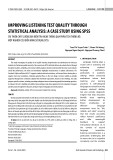


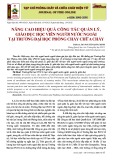
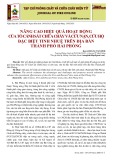
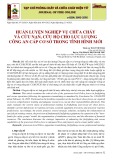
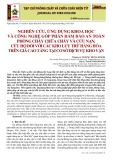


![Đề thi kết thúc học phần Nguyên lí Hóa học 2 [mới nhất]](https://cdn.tailieu.vn/images/document/thumbnail/2025/20251014/anhinhduyet000/135x160/69761760428591.jpg)













